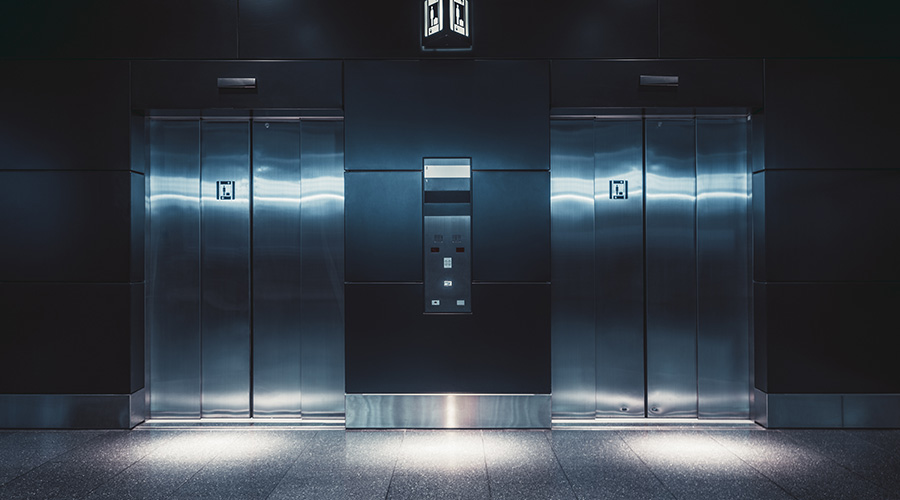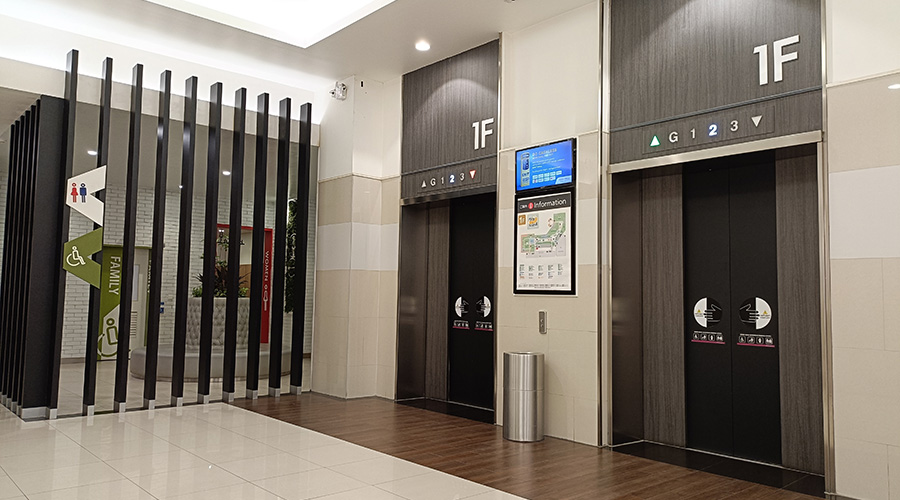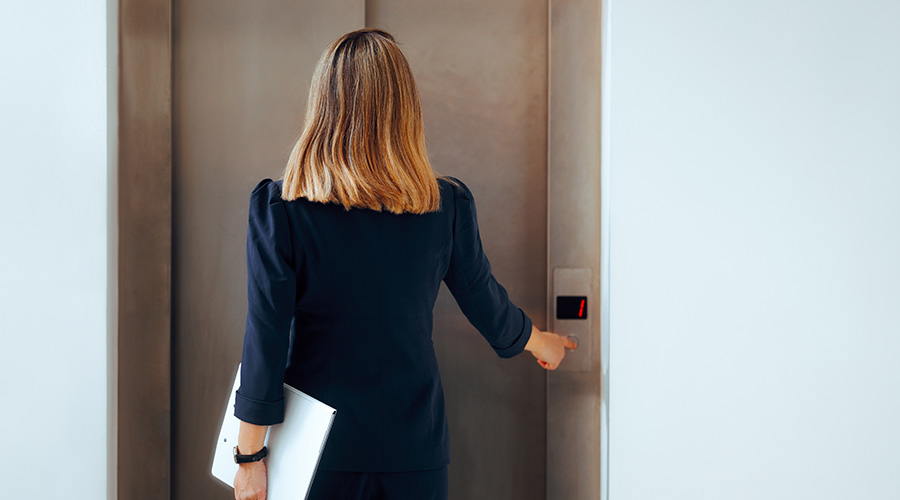Weighing Elevator Modernization Factors
Elevator modernization can improve reliability and performance. But when is the right time to modernize?
By Brandon Lorenz, Senior Editor
What goes up must come down. Unfortunately, in the case of elevators, there is no law of physics saying that they must do so reliably, efficiently or quickly.
Elevators have service lives that can exceed 20 years, so it’s understandable that facility executives don’t spend a lot of time thinking about their elevators until performance slips. When that starts to happen, facility executives face a question: Is it time to modernize? Deciding when to modernize an elevator isn’t easy, because the factors that may drive modernization in one facility may not be important in another. The capital required to modernize an elevator system, combined with the inconvenience to occupants, puts a premium on getting the decision right.
Factors That Drive Modernization
Normally a few key reasons push facility executives to take a closer look at their elevators. A big one is tenant satisfaction.
In Class A office buildings, expectations can be high. In a law firm with 100 attorneys each billing $250 an hour, an elevator that takes an extra minute can quickly add up, says Scott Sticew, associate partner with Syska Hennessy Group.
“I think it all goes back to customer satisfaction,” says Ron Koljonen, associate partner with Syska Hennessy Group. “The expectations and demands of the tenants are higher.”
With tenant demands high, the need to remain competitive in the marketplace may force a modernization. “In Class A buildings, we see a lot of owners take the initiative on a competitive basis,” says John Moran, senior vice president with Syska Hennessy Group.
Assuming competitive pressures aren’t forcing a modernization, the other thing to consider is service calls. Elevator companies don’t report service calls in the same way, so facility executives should try to look at service calls over time, says Marc Cerniglia, principal with Ascent Service and Technology. Cerniglia suggests tracking service calls per unit per year using a 12-month moving window. Plotting a line to show the cumulative calls over the preceding 12 months shows if performance is getting better or worse.
An increase in service calls or an excessive number of service calls are clear signs of slipping reliability.
Benefits of Modernization
Improved reliability is one major modernization benefit, particularly if maintenance has been uneven over the years. But there are other potential benefits.
Today’s elevators are more efficient at moving people. “The perception among nine out of 10 people is that the elevators have become faster,” says Jay Popp, executive vice president with Lerch Bates. “Faster to them means speed. But that’s really not the case.”
Physical limitations mean that elevators almost never become physically faster after a modernization. Instead, more advanced electronics improve the efficiency of dispatching systems, which reduces wait times.
An elevator with modern electronics can cut down on wasted trips, even if it only uses a conventional dispatching system. New elevators recognize “coincidental trips,” which reduces the tendency to send a car to an empty floor because someone has boarded an elevator that was dropping off an occupant, says Popp.
Other advances include microprocessors that learn the traffic patterns of a building and position elevators at high demand floors during busy times. Such systems can also adapt to changes in building use as tenants come and go.
Acceleration and deceleration rates can improve and doors can open and close faster, which also improves the ability to move people, says Sticew.
Facility executives looking for a larger improvement in efficiency should consider a destination dispatch system. Instead of using push buttons in a lobby, occupants enter their destination floor. The dispatch system then picks the most efficient elevator to carry the passenger — which may not be the next arriving one. Grouping destinations improves performance compared to a traditional dispatching system.
Destination dispatch could improve handling capacity by as much as 25 percent, says Moran. That can be especially important in older buildings where occupancy has grown over time.
Destination dispatch systems can be configured to work with a proximity card. That eliminates the need for occupants to enter anything on a control panel. It also offers the ability to give individual occupants private elevator rides, without designating a separate elevator, Popp says. Occupants who have the privilege have it encoded in their card. The elevator recognizes the card and sends them directly to their destination without stopping.
Improved energy efficiency is another benefit to modernization. For a building with especially old elevators, the best-case improvement could be as much as 40 percent, says Popp.
Buildings that have elevators from the 1970s or 1980s may see gains of 10 or 15 percent. In any case, because modernizing an elevator is so expensive, efficiency improvements are a value added benefit, not one that is compelling enough on its own to drive a modernization. The savings is very difficult to put into actual numbers, says Koljonen.
Modern elevators improve efficiency by feeding energy back into the building when they are descending. Older units capture the energy during descent but instead burn it off in resister banks as heat. That’s an especially inefficient design because the heat is usually discharged into the machine room, which increases the machine room’s cooling load.
One possibility sometimes overlooked during a modernization is the ability to reduce electromagnetic noise. Computers and wireless networks are sensitive to electromagnetic noise. Some solid-state elevator drives generate less noise than others, says Popp. Some cleaner drives come with a cost premium, so facility executives need to weigh options during bidding.
Making the Modernization Case
A common rule of thumb in the industry is that if an elevator is 20 years old, it’s probably a candidate for replacement. In some cases, that might be true. But with costs to modernize an elevator approaching $250,000 a unit, a more analytical approach is clearly in order.
Facility executives considering a modernization should conduct a pre-modernization evaluation. National Elevator Industries Inc. (NEII) offers a free checklist that helps determine objectively how an elevator is performing. Among the characteristics to be measured: acceleration, deceleration, vibration, door opening times and sound.
“You can put 10 people in an elevator and get 10 opinions on ride quality,” says Cerniglia. “Using an accelerometer and measuring is the only way to have real standards.”
A pre-modernization evaluation can also reveal deficiencies in the existing maintenance program. The condition of hoist ropes, for example, can be easily overlooked during routine maintenance.
“I can’t tell you how many times projects go out to bid and the incumbent maintenance contractor hopes they don’t get called on the carpet,” says Moran.
Because relatively small changes can significantly compromise performance, it’s possible for a pre-modernization evaluation to uncover problems that, if repaired, could postpone the need for a complete modernization.
“For the cost of evaluation compared to a modernization, you’re definitely saving a lot of money,” says Koljonen.
In such cases, the goal is simply to make sure the elevator comes as close as possible to its original specification.
“With elevators, it’s very easy to lose 10 percent of system performance because we deal with such small increments of time,” says Popp.
Consider a bank of six elevators where one set of doors was opening two-tenths of a second slower than normal. Perhaps another elevator had slowed by two seconds because of improper acceleration. If the typical elevator setup calls for an elevator to be able to leave the lobby every 30 seconds, those lost seconds can quickly translate into an extra carload of occupants waiting in the lobby during peak demand, Popp says.
If budgets are tight, a pre-modernization evaluation may help target the components most in need of improvement. An evaluation may reveal that the best bet is to focus on a control modernization. Or a door operator modernization may be the most cost-effective option if funds are tight.
If a full modernization is eventually planned, a phased modernization isn’t the most efficient approach, Popp says. But sometimes there is little choice.
“We have a situation right now where the owner has under budgeted,” Cerniglia says. “We’re in the process right now of trying to figure out how to meet the financial terms.”
In such cases, facility executives may decide to upgrade to a closed loop door operator system and install a new control system later. It’s important to make sure the door operators chosen are compatible with controls equipment that will be installed later, Cerniglia says.
Along with the improved appearance of new door operators, closed loop operators improve performance because they monitor door position throughout operation. The system can determine if there is extra drag on the motor because something is stuck in the track or because there is a pressure problem and adjust operation accordingly.
“If you have the choice between medium duty and heavy duty with a closed loop option, the closed-loop option is a wise idea,” Popp says.
Finally, a comprehensive pre-modernization evaluation helps avoid surprises once work begins. It’s not unusual for a full elevator modernization to require work on other building systems. “When you start thinking about an elevator modernization, you have to think of the code requirements,” says Edward Donohue, managing director and spokesman for NEII.
Sometimes code changes require retroactive fire and life safety improvements. Older fire alarm systems may need to be upgraded to accept a smoke sensor in the main lobby, says Moran. On the West Coast, some jurisdictions may require upgrades to meet seismic codes. “It’s very important to know what code jurisdiction you are in,” says Sticew.
Impact on the Power Infrastructure
Electrical issues also need to be considered. An old standby generator may not be compatible with a new solid-state drive because the drives don’t tolerate variations in power quality well, says Moran.
In one case, an 80-story building was moving from a motor/generator setup to solid-state drives. But that move required an upgrade to the building’s electrical feeders when it was discovered that the existing aluminum feeders wouldn’t support the peak inrush of current required to energize the drives. “The switch from motor generator sets to drives is one big thing people don’t anticipate,” Cerniglia says.
While sometimes overlooked, conducting a detailed inspection on a regular basis can also help facility executives because it avoids the potential for surprise breakdowns. A regular testing program can help better shape capital spending plans. That’s especially important because today’s microprocessor-controlled elevators won’t have replacement parts forever, says Popp.
“There’s really a need for a new management strategy in buildings,” says Popp. “Imagine trying to take a 15-year-old laptop in for service and trying to find parts. Facility executives need to think of elevator controls like roofs. You might go 20 years and reach the end of your service life.”
CHARTING THE CHANGE
Work on Elevator Evacuation Continues
Work continues in the wake of the collapse of the World Trade Center to examine whether elevators should be used for evacuations.
For decades, occupants have been told not to use an elevator during a fire. The World Trade Center collapse has called that approach into question. Elevator operation during a fire is governed by the American Society of Mechanical Engineers (ASME) A17 Life Safety Code for Elevators and Escalators. A17 is the basis for most requirements adopted at the local level.
ASME has been conducting a hazard analysis since 2004 to determine whether to recommend changes to A17. That analysis is more than 200 pages and still not complete, says Edward Donohue, managing director and spokesman for National Elevator Industries Inc.“This isn’t a simple little change. There are many hazards that have to be looked at and mitigated,” says Donohue, who is hoping the process can be complete by midyear.
There are technological and behavioral challenges to deal with as well. For example, how would smoke be dealt with? Instructing occupants when it’s appropriate to evacuate via an elevator is no easy task because the decision could vary depending on the building, the type of emergency and where the occupants are located. That question would likely require changes to elevator control systems.
Compounding the difficulty in using elevators for evacuation is that any potential changes would likely impact fire codes, building codes and elevator codes, Donohue says. “One code can’t control all of it,” he says.
|
THE ROLE OF MAINTENANCE
Maintenance and Modernization Factors
One of the first things to consider when deciding whether to modernize an elevator: Has it been properly maintained?
“If you don’t maintain an elevator properly, you’re clearly not going to get the optimal life out of the components,” says Marc Cerniglia, principal with Ascent Service and Technology.
Most buildings — especially Class A offices — have elevators that are periodically tested and maintained by an elevator maintenance contractor. But before embarking on a modernization, facility executives should find out whether they are getting the maintenance they are paying for. Maintenance contracts vary in quality and scope — from full maintenance agreements to those that require payment for each service call.
Assuming a full maintenance contract is in place, the quality of the work is important because a full maintenance contract should keep an elevator working to its original specifications throughout its life. The approach is similar to the way airlines maintain their fleets — the airframes stay the same, but over time the engines, interiors and electronics are all replaced. “The only thing that should do you in is parts obsolescence,” says Cerniglia.
Poor maintenance can compromise performance and cause occupant complaints that require premature modernization. Some elevator maintenance contractors have been under pressure to cover more units over time, shrinking the amount of time they can spend on individual units. It’s a recipe for slipping maintenance.
“Maintenance prices have eroded so much that the work isn’t always getting done,” says Jay Popp, executive vice president with Lerch Bates. The contracts all say the right things. “But the quality and attention to detail that we used to have just isn’t there,” he says.
|
Related Topics:











